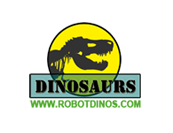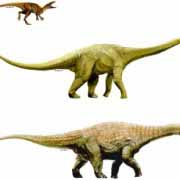Dinosaur bones scanned to discover more about weighty issue

Palaeontologist Scott Hocknull analyses the Diamantinasaurus fossils at the Australian Age of Dinosaurs facility in Winton, Western Queensland.
It was a scan 100 million years in the making.
The bones of one of Queensland’s largest dinosaurs, Matilda, have undergone a CT scan to discover how her limbs coped with 20 tonnes of flesh on top.
University of New England PhD student Ada Klinkharmer borrowed some of the sauropod’s leg and hip bones from their home at Australian Age of Dinosaurs in Winton, and had them tested at Mt Isa Hospital.

Artistic representations of the three dinosaur taxa described here. Australovenator (top); Wintonotitan (middle); Diamantinasaurus (bottom). Photo: Artwork by: T. Tischler, Australian Age of Dinosaurs Museum of Natural History.
“We create 3D computer models and we can put forces on them, and measure the stress,” she said.
Advertisement
“We can look at the bones we’ve measured and look at how that stress is distributed around the limbs, and discover how these dinosaurs bore their weight.”Diamantinasaurus matildae was discovered in June 2005 at the Winton Formation. She would have been 15 to 16 metres long and 2.5 metres high at the hip.Ms Klinkharmer said it is a common supposition that the large, long-necked herbivores stood on hind legs to graze, but it’s never been proven.”Using this method, we can actually physically test if the bones were capable of sustaining 20 odd tonnes on just two legs,” she said.”Obviously they had to raise up onto their hind legs for mating, but whether or not they could do it for a sustained length of time is the question.”She said the CT scan was an interesting process.”You’ve got to be careful to make sure you don’t break anything in the process,” Ms Klinkharmer said.”But it works exactly the same as when you CT scan a person – you put it on the table, slide it in and scan it.”However, she admitted not being able to scan the thigh bone was disappointing.”It’s obviously made of rock now, and it’s so heavy, the CT scan can’t support the weight of the femur.”Ms Klinkharmer, whose work on biomechanics forms part of the Function, Evolution and Anatomy laboratory at UNE, hopes to publish her results early next year. Dinosaur fans will be able to see some theories about how dinosaurs may have moved at the Queensland Discovery from March 27, which features more than 20 life-size dinosaur animatronics.

